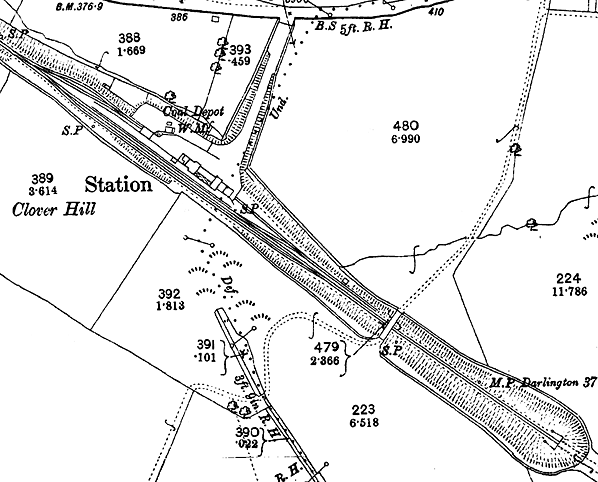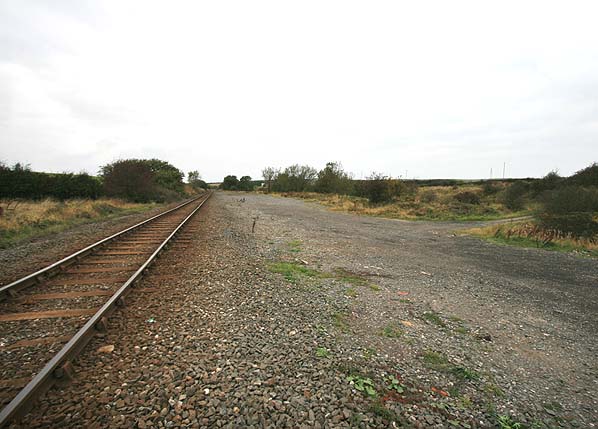Notes: The station opened on 3rd December 1883 as Easington and was renamed Grinkle on 1st April 1904. Originally there was a single platform station on the ‘up’ side a single line. A wooden signal box was provided. A loop with a second platform made of cinder and old sleepers was added about 1906 to comply with Board of Trade regulations that required that "a passenger train must be alongside a platform when standing in a station." This meant that only a goods train could pass a passenger train at stations with a single platform. Stations with only one platform and a passing loop were equipped with a second platform so that passenger train capacity of the line could be increased. There was a small goods yard one siding situated to the west of the station on the ‘down’ side of the line, this served a coal depot. A short distance east of the station the line entered Grinkle tunnel.
The station had a brick building incorporating the stationmaster’s house and a signalbox on the ‘down’ platform with a wooden waiting shelter on the ‘up’ platform. The ‘down’ platform buildings were demolished after closure leaving the signalbox. The waiting shelter on the ‘up’ platform survived into the 1950’s when the platform was partly demolished.
The station closed during the winter of 1938/1939 but was reopened on 28th May 1939 but closed again 11th September 1939, the first station on the line to close. Following closure the track formation was retained and used as a passing loop.
The track through the station was lifted during the 1960's. The station was probably cleared when the line to Boulby Potash Mine was re-laid reopening on 1st April 1974.
BRIEF HISTORY OF TEESIDE - WHITBY VIA THE COAST
Trains from Teesside to Whitby started operation on 3rd December, 1883 with a northern terminus at Saltburn. Trains for Whitby Town reversed at Saltburn West Junction to allow them to take the extension line from Saltburn to Brotton and thence follow the coastal line to Whitby through Loftus which up to then had been a terminus.
On 16th July 1885 the line from Whitby to Scarborough was opened so allowing some trains to run through to Scarborough. These trains called at Whitby West Cliff which was connected to Whitby Town by a shuttle service.
 |
In the summer of 1933 the northern terminus was changed to Middlesbrough and trains were then routed by way of Nunthorpe, Guisborough and Boosbeck to meet the original route at Brotton. A reversal was required on this route at Guisborough where rules were relaxed and trains of up to seven coaches in length were propelled in and out of the |
station which was at the end of a spur. Occasional summer trains would make Brotton via Redcar and the Saltburn extension.
Closure of the railway started pre Beeching with the Brotton to Saltburn section closing to passengers on 6th September 1957, Whitby West Cliff to Loftus closing to all traffic on 3rd May 1958, Loftus to Boosbeck closing to passengers on 30th April 1960 and the section from Boosbeck to Guisborough closing to all traffic on the same day. The line from Boosbeck to Brotton was closed completely on 12th September 1964.
The line remained open for goods from Saltburn West Junction through to Skinningrove and following the opening of a potash mine at Boulby the line was reinstated for the carriage of minerals between Skinningrove and Brotton from 1st April 1974.
The coastal rail link between Teesside and Whitby used a number of pre existing railway routes which had been constructed primarily with the ironstone mining activities as their main motivation. The individual lines are described below:
WHITBY - LOFTUS (The Whitby, Redcar and Middlesbrough Union Railway)
Railways came to Whitby early with the opening of the Whitby – Grosmont Railway on 15th May 1835. The line was extended to Pickering as a horse worked line on 26th May 1836 and on 7th July 1845 the Whitby – Pickering Railway was extended to Malton.
In 1864 a bill was submitted to Parliament for a Scarborough, Whitby and Staithes Railway but this was rejected
On 16th July 1866 the Whitby, Redcar and Middlesbrough Union Railway was incorporated with the intention of linking Whitby to Lofthouse (Loftus) with a line along the coast. The line was intended to branch off the Whitby - Grosmont line 93 yards short of Ruswarp station. Another short branch was planned here to join the proposed Whitby to Scarborough Railway at Larpool Wood.
Because of a lack of finance it took until 3rd May 1871 for the contract to build the Whitby, Redcar and Middlesbrough Union Railway to be signed. The contractor was John Dickson. Construction of the new railway started on 25th May 1871 when the first sod was cut near Sandsend by the Dowager Marchioness of Normanby.
On 7th July 1873 an Act was passed authorising an amended route with the WRMRU now branching from the Whitby – Grosmont line just outside Whitby Town station. The link to the proposed Scarborough line at Larpool Wood was dropped. By 1874 the construction of the railway had stopped and the contractor had gone into liquidation. Two of the contractors locomotives which had been taken over by the WRMUR were sold. On 1st July 1875 the North Eastern Railway took a perpetual lease over the WRMUR and employed another contractor, John Waddell of Edinburgh, to complete the line with a completion date of 13th July 1881. The WRMUR Act ratified the arrangement on 19th July 1875 and the NER agreed to complete the line in a substantial and satisfactory manner.
old1.jpg) The new contractor found the previous work to be unsatisfactory and in the short period whilst work was suspended part of the cliff route north of Sandsend had collapsed into the sea. The new contractors drove the railway through the headlands rather than go round them. Two tunnels were constructed, Sandsend tunnel (1652 yards) and Kettleness tunnel (308 yards); between them a short stretch of the original course along the cliff edge remains. Five steel tubular viaducts were erected on the line at Upgang (330 ft long, 70 ft high with 6 spans), Newholm Bank (330, 50, 11), East Row (528, 30, 8), Sandsend (268, 63, 8) and Staithes (790, 152, 17). Staithes viaduct was protected by a wind gauge which rang a bell in the signal box when the wind pressure reached 28 lb/sq. ft. At this point traffic over the viaduct was suspended and could only be resumed after the structure had been inspected. The new contractor found the previous work to be unsatisfactory and in the short period whilst work was suspended part of the cliff route north of Sandsend had collapsed into the sea. The new contractors drove the railway through the headlands rather than go round them. Two tunnels were constructed, Sandsend tunnel (1652 yards) and Kettleness tunnel (308 yards); between them a short stretch of the original course along the cliff edge remains. Five steel tubular viaducts were erected on the line at Upgang (330 ft long, 70 ft high with 6 spans), Newholm Bank (330, 50, 11), East Row (528, 30, 8), Sandsend (268, 63, 8) and Staithes (790, 152, 17). Staithes viaduct was protected by a wind gauge which rang a bell in the signal box when the wind pressure reached 28 lb/sq. ft. At this point traffic over the viaduct was suspended and could only be resumed after the structure had been inspected.
The Whitby – Loftus line was ready for use on 3rd December 1883, 2 1/2 years behind schedule and the first train left Whitby station. The new line served stations at Whitby Town, Whitby West Cliff, Sandsend, Kettleness, Hinderwell, Staithes, Easington (renamed Grinkle in April1904) and Loftus. The line formed an end on junction with the route of the former Cleveland Railway at Loftus so allowing trains to run through from Whitby to Saltburn using the former Cleveland Railway route and the later NER connection between Brotton and Saltburn. On 16th July 1885 the Scarborough and Whitby railway opened and joined onto the WRMUR at Prospect Hill Junction so allowing direct trains to run between Scarborough and Saltburn.
The line exploited the camping coach business with coaches being provided at Sandsend (2), Kettleness (2) and East Row (3) between 1933 and 1939. The business was suspended during the war and opened again in 1952.
On 3rd May 1958 the line was closed completely between Whitby (West Cliff) and Loftus and Loftus reverted to becoming a terminus for trains from Teesside until its closure for passengers on 30th May 1960 and goods on 10th August 1963. Whitby (West Cliff) remained open for trains ex Scarborough until 10th June 1961. From this date Scarborough – Whitby trains reversed at Prospect Hill Junction for Whitby Town station.
A new potash mine was opened near to the route of the railway north of Staithes. On 1st April 1974 the line was reopened for mineral traffic from the new Boulby Potash Mine to reach existing rail facilities at Skinningrove and it remains in operation
Sources:
- Railways around Whitby (Vols. 1 and 2) – Martin Bairstow
- The Whitby, Redcar and Middlesbrough Union Railway by K. Hoole
- Regional History of the Railways of Great Britain – Vol. 4 The North East by K. Hoole
- Railway Memories No 18 – Cleveland and Whitby – Stephen Chapman
Tickets from Michael Stewart, all un attributed photographs received from Neil Cholmondeley
Further reading: Railways Around Whitby Volumes One and Two written and published by Martin Bairstow. ISBN 978-1-871944-34-1
To see other stations on the Saltburn - Whitby line click on the station name: North Skelton, Brotton, Skinningrove, Loftus, Staithes, Hinderwell, Kettleness, Sandsend & Whitby West Cliff. See also Boosbeck & Guisborough
See also Boulby Mine |

old5.jpg)


old2.jpg)
old4.jpg)



old1.jpg) The new contractor found the previous work to be unsatisfactory and in the short period whilst work was suspended part of the cliff route north of Sandsend had collapsed into the sea. The new contractors drove the railway through the headlands rather than go round them. Two tunnels were constructed, Sandsend tunnel (1652 yards) and Kettleness tunnel (308 yards); between them a short stretch of the original course along the cliff edge remains. Five steel tubular viaducts were erected on the line at Upgang (330 ft long, 70 ft high with 6 spans), Newholm Bank (330, 50, 11), East Row (528, 30, 8), Sandsend (268, 63, 8) and Staithes (790, 152, 17). Staithes viaduct was protected by a wind gauge which rang a bell in the signal box when the wind pressure reached 28 lb/sq. ft. At this point traffic over the viaduct was suspended and could only be resumed after the structure had been inspected.
The new contractor found the previous work to be unsatisfactory and in the short period whilst work was suspended part of the cliff route north of Sandsend had collapsed into the sea. The new contractors drove the railway through the headlands rather than go round them. Two tunnels were constructed, Sandsend tunnel (1652 yards) and Kettleness tunnel (308 yards); between them a short stretch of the original course along the cliff edge remains. Five steel tubular viaducts were erected on the line at Upgang (330 ft long, 70 ft high with 6 spans), Newholm Bank (330, 50, 11), East Row (528, 30, 8), Sandsend (268, 63, 8) and Staithes (790, 152, 17). Staithes viaduct was protected by a wind gauge which rang a bell in the signal box when the wind pressure reached 28 lb/sq. ft. At this point traffic over the viaduct was suspended and could only be resumed after the structure had been inspected.old_thumb3.jpg)


thumb3.jpg)


 Home Page
Home Page